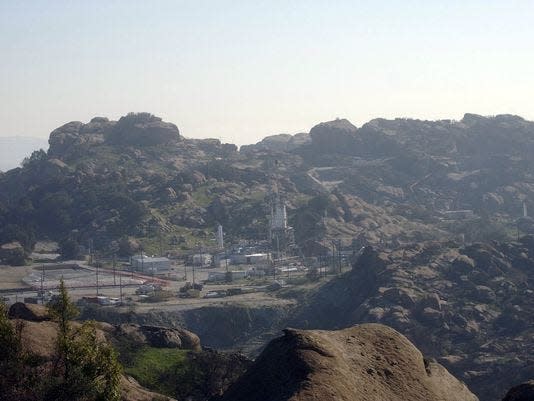Cleanup activists say new agreement with Boeing weakens field lab remediation
- Oops!Something went wrong.Please try again later.

Santa Susana Field Lab cleanup activists say the long-delayed remediation of the contaminated site will be weakened by a new state agreement with Boeing, which owns most of the property outside Simi Valley.
The California Environmental Protection Agency announced this month that the agreement will strengthen the cleanup of Boeing's portion of the 2,850-acre site, which experienced a partial nuclear meltdown in 1959. State officials say the pact establishes strict remediation protocols and timelines for the aerospace giant.
“Santa Susana Field Lab is one of our nation’s most high-profile and contentious toxic cleanup sites," Gov. Gavin Newsom said in a release. "For decades, there have been too many disputes and not enough cleanup."
The settlement "prioritizes human health and the environment and holds Boeing to account for its cleanup," Newsom said.
But Dan Hirsch, a leading cleanup activist, said Thursday the agreement between Boeing and the EPA's Department of Toxic Substances Control does no such thing.
"I'm horrified," said Hirsch, president of Committee to Bridge the Gap, a nonprofit nuclear policy organization, and the retired director of the Program on Environmental and Nuclear Policy at UC Santa Cruz. "It is vastly worse than I ever imagined."
Questions raised: Were Boeing's fines after Woolsey Fire reduced because of a conflict of interest?
Hirsch said that rather than establishing strict cleanup standards as a three-page EPA news release states, the actual 796-page agreement reveals that the standards have been significantly relaxed compared to a 2007 remediation agreement between the state and Boeing.
Under that agreement, Boeing was supposed to have cleaned up its portion of the site by 2017. But the cleanup hasn't yet begun.
"This new agreement, which supersedes much of the 2007 agreement, would allow higher concentrations of toxic chemicals to remain not cleaned up," Hirsch said. "The vast majority of the contamination at the site will now never get cleaned up as agreed by Boeing and the state."
Another cleanup activist, Melissa Bumstead, agrees.
"It's a sham of a cleanup agreement," said Bumstead, a West Hills resident who founded the activist group Parents Against Santa Susana Field Lab after her four-year-old daughter Grace was diagnosed with leukemia in 2014. "I believe it dramatically weakens the standards."
Upon reading the agreement, "I cried for two days," said Bumstead, who believes toxic contamination from the contaminated site contributed to Grace's illness.
Kalin Kipling-Mojaddedi, an EPA spokeswoman, said in a statement Friday that "any assertion that the toxic substances control department has watered down the cleanup standard is false."
Though the EPA release says the new accord establishes strict timelines for Boeing's cleanup, when pressed, Kipling-Mojaddedi would only say that her agency "expects" the remediation to begin in 2025. She said timelines will be outlined in a final environmental impact report that the toxic substances control department intends to release in the fall.
Investigation: County probes whether dust drifted from contaminated field lab site because of detonations
Boeing spokesman Connor Greenwood said in a statement that the company supports the agreement "as it provides regulatory certainty and a clear, accelerated path forward for Boeing’s cleanup. It also reflects Boeing’s deep commitment to safety, sustainability and the communities where we live and work."
The site suffered the meltdown when it was the Rocketdyne/Atomics International rocket engine and nuclear facility, a premier research facility for the United States during the Cold War. The site also experienced other chemical and radioactive contamination over the years.
The EPA says that under the new agreement, Boeing is tasked with cleaning up radioactive contamination in the soil to the most stringent “background" level.
But Hirsch said that is misleading because the contamination is primarily in another portion of the site, which is the Department of Energy's cleanup responsibility.
Also, under the new settlement, Boeing is supposed to remediate chemical contamination to a health standard that could be as stringent as the “resident with garden” standard, ensuring that it would be safe for people to live onsite and consume homegrown produce.
Hirsch, however, noted that the pact says Boeing "could" remediate to that standard, not will remediate to it.
Kipling-Mojaddedi said the latest agreement is not only consistent with the 2007 agreement but goes further.
"It secures Boeing’s agreement to clean up radiological contamination to background levels," she said, which goes beyond the "standard called for in the 2007 agreement."
Local officials praised the new understanding, which establishes penalties of up to $70,000 a day for violations, the state says.
"It is outstanding to get agreement on the removal of radiological contaminants to the cleanest level," Ventura County Supervisor Linda Parks said in a statement.
Simi Valley Mayor Keith Mashburn said in a statement he was pleased that the new agreement "will restore the site to its natural state, create a safer environment for thousands of residents and preserve the land for future generations.”
Mike Harris covers the East County cities of Moorpark, Simi Valley and Thousand Oaks, as well as transportation countywide. You can contact him at mike.harris@vcstar.com or 805-437-0323.
SUPPORT LOCAL JOURNALISM and get all the latest Moorpark, Simi Valley, Thousand Oaks, and transportation news from Star reporter Mike Harris. Get a digital subscription
This article originally appeared on Ventura County Star: Latest field lab cleanup agreement torched by activists
